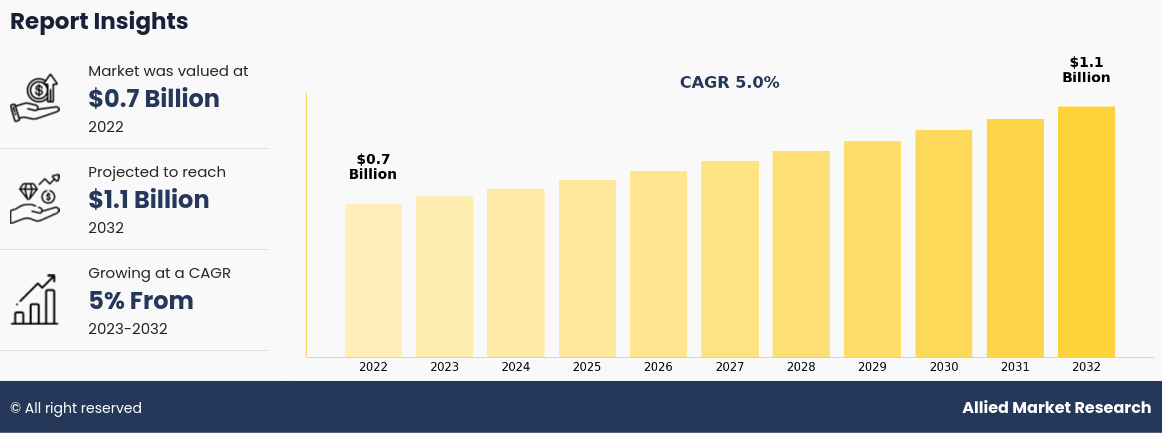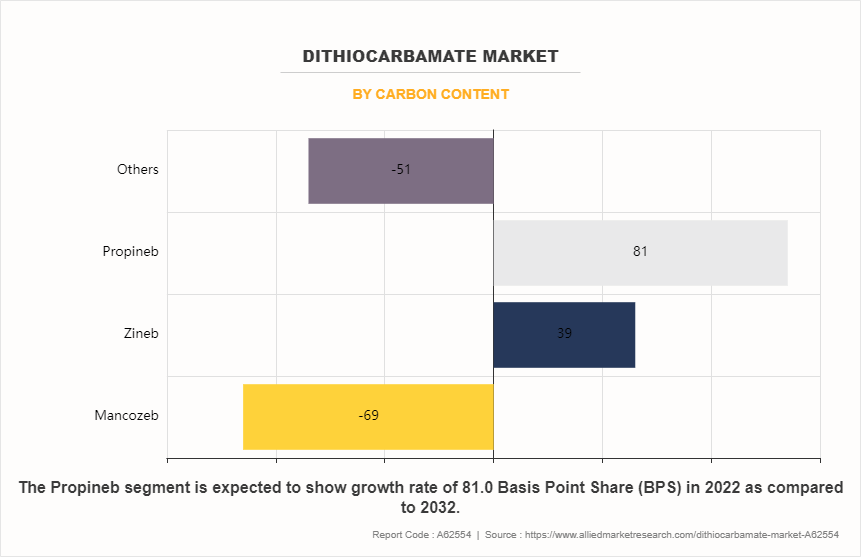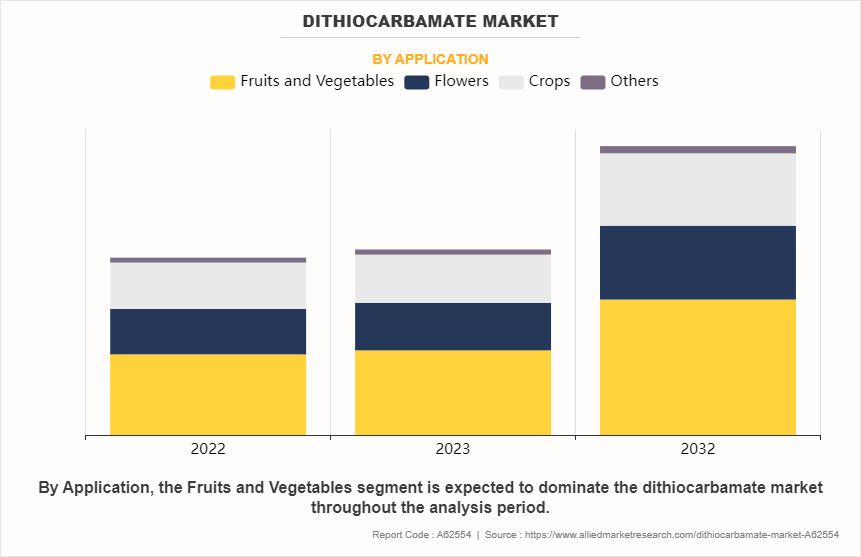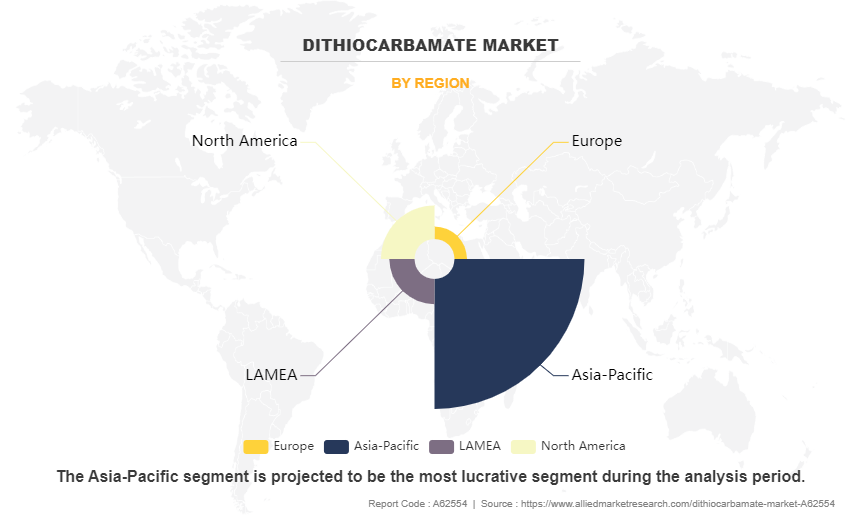Dithiocarbamate Market Research, 2032
The global dithiocarbamate market was valued at $0.7 billion in 2022, and is projected to reach $1.1 billion by 2032, growing at a CAGR of 5.0% from 2023 to 2032. Dithiocarbamates have been investigated for their potential therapeutic applications. Some derivatives exhibit anti-cancer properties, with studies exploring their ability to inhibit tumor growth. They have also been studied for their antiviral activities, particularly against HIV.

Introduction:
Dithiocarbamates are a class of chemical compounds containing the functional group "R2NCS2-", where R represents an organic group. They are widely used in various industrial, agricultural, and medicinal applications. The unique structure of dithiocarbamates makes them versatile and valuable in different fields.
In agriculture, dithiocarbamates serve as fungicides, protecting crops from fungal infections. Compounds like maneb and zineb are commonly used to control diseases in fruits and vegetables. In the rubber industry, dithiocarbamates function as accelerators in the vulcanization process, contributing to the production of durable and elastic rubber products.
Key Takeaways:
- The report provides competitive dynamics by evaluating business segments, product portfolios, target market revenue, geographical presence and key strategic developments by prominent manufacturers.
- The dithiocarbamate market is consolidated in nature among prominent companies such as AkzoNobel, Arkema, LANXESS, Albemarle Corporation, TCI Chemicals, Thermo Fisher Scientific, Merck, SIDDHARTH CHEMICALS, Nouryon, and Jinchangsheng Chemical Technology Co.,Ltd. .
- The study contains qualitative information such as the market dynamics (drivers, restraints, challenges, and opportunities), key regulation analysis, pricing analysis, and Porter‐™s Five Force Analysis across North America, Europe, Asia-Pacific, LAMEA regions.
- Latest trends in global dithiocarbamate market such as undergoing R&D activities, public policies, and government initiatives are analyzed across 16 countries in 4 different regions. Moreover, the consumption of dithiocarbamate is also studied across non-EU countries for providing better understanding of the market.
- More than 3,000 dithiocarbamate-related product literatures, industry releases, annual reports, and other such documents of key industry participants along with authentic industry journals and government websites have been reviewed for generating high-value industry insights for global dithiocarbamate market.
Market Dynamics:
Rise in demand for fungicides in agriculture is a significant driver of the dithiocarbamate market. Dithiocarbamates, particularly mancozeb and ziram, are widely used to control fungal diseases in crops. With the increasing global population, there is a growing need to enhance agricultural productivity to meet food demands. Farmers rely on fungicides to protect crops from diseases, ensuring a stable and high-quality yield. According to a report published by Pres Information Bureau in 2023, the agriculture sector in India has been witnessing robust growth with an average annual growth rate of 4.6% from 2017-2023. The adoption of modern agricultural practices, such as precision farming and greenhouse cultivation, further drives the demand for effective fungicides such as dithiocarbamates.
Furthermore, dithiocarbamates find extensive use in the rubber industry as accelerators in the vulcanization process. The rubber industry, a crucial component of the automotive and manufacturing sectors, heavily influences the demand for dithiocarbamates. According to a report published by Alliance for Automotive Innovation in 2022, the automotive industry in the U.S. accounts for 5% of the American economy. As these industries experience growth, the demand for rubber products, including tires, conveyor belts, and seals, increases, thereby boosting the demand for dithiocarbamate accelerators.
In addition, the dithiocarbamate market is significantly impacted by regulatory frameworks governing the use of these chemicals. Governments globally have established regulations to ensure the safe use of agrochemicals and industrial chemicals, including dithiocarbamates. Stringent regulations regarding product registration, labeling, and maximum residue limits in agricultural products can influence market dynamics. In addition, increasing environmental concerns and the focus on sustainable practices drive the development of eco-friendly alternatives and impact the market's growth trajectory.
However, one of the primary restraints of the dithiocarbamate market is the stringent regulatory environment. Governments globally have implemented various regulations to ensure the safety and environmental impact of chemicals, including dithiocarbamates. The industry must comply with these regulations, which often involve extensive testing, documentation, and adherence to safety protocols. This can lead to increased operational costs for manufacturers and may slow down the introduction of new products.
Environmental concerns also pose challenges for the dithiocarbamate market. The use of these chemicals in agriculture, particularly as fungicides, has raised questions about their impact on ecosystems and human health. As a result, there is a growing demand for eco-friendly alternatives, putting pressure on manufacturers to invest in research and development for more sustainable solutions.
However, the mining industry is also contributing to the growth of the dithiocarbamate industry. Dithiocarbamates are used as collectors in the flotation process for extracting minerals from ores. With the demand for various metals and minerals remaining robust, especially in emerging economies, the mining sector is poised for expansion. As a result, the demand for dithiocarbamates in mineral processing is expected to increase, creating opportunities for market players. According to a report published by the National Investment Promotion and Facilitation Agency in 2022, the mining industry in India allowed 100% foreign direct investment (FDI), which in turn has led the overall mining sector to witness a significant increase in growth.
Segment Overview:
The dithiocarbamate market is segmented on the basis of carbon content, application, and region. On the basis of carbon content, the market is categorized into mancozeb, zineb, propineb, and others. By application, the market is classified into fruits and vegetables, flowers, crops, and others. Region-wise, the market is studied across North America, Europe, Asia-Pacific, and LAMEA.

In 2022, the mancozeb segment was the largest revenue generator, and is anticipated to grow at a CAGR of 4.9% during the forecast period. Mancozeb is widely known for its broad-spectrum fungicidal activity, making it effective against a wide range of plant diseases caused by fungi. This effectiveness in controlling diseases such as blights, rots, and mildews makes it a popular choice among farmers and gardeners. Furthermore, with the increasing prevalence of fungicide resistance in pathogens, there is a growing need for alternative fungicides. Mancozeb's mode of action differs from that of other fungicides, making it useful in resistance management strategies.

By application, the fruits and vegetables segment dominated the global market in 2022, and is anticipated to grow at a CAGR of 5.4% during forecast period. Dithiocarbamates have broad-spectrum fungicidal properties, making them effective against a wide range of fungal pathogens that affect fruits and vegetables. Diseases such as blights, rots, mildews, and other fungal infections can significantly impact crop yield and quality. Dithiocarbamates provide effective control, reducing losses due to these diseases. Moreover, as agricultural practices expand to meet the growing global demand for fruits and vegetables, there is an increased need for effective disease management strategies. Dithiocarbamates offer farmers a reliable tool to control fungal diseases and ensure healthy crop production.

The Asia-Pacific dithiocarbamate market size is projected to grow at the highest CAGR of 5.3% during the forecast period. The Asia-Pacific region is experiencing rapid agricultural expansion driven by population growth, urbanization, and changing dietary habits. As more land is brought under cultivation to meet the growing demand for food, there is an increased need for effective crop protection products like dithiocarbamates to manage diseases and pests. Also, Asia-Pacific region is known for its diverse range of crops, including rice, wheat, fruits, vegetables, and cash crops like tea and coffee. Many of these crops are susceptible to fungal diseases, and dithiocarbamates offer broad-spectrum fungicidal activity, making them valuable for disease management across different crops.
With the growing demand for food, there is pressure on farmers to intensify crop production to maximize yields. This intensification often involves practices such as high-density planting, continuous cropping, and monoculture, which can increase the risk of disease outbreaks. Dithiocarbamates help mitigate these risks by providing effective disease control.
Furthermore, climate change is leading to shifts in temperature and precipitation patterns, creating favorable conditions for the spread of fungal diseases in many parts of the Asia-Pacific region. Dithiocarbamates offer farmers a reliable tool to combat these emerging disease threats and protect their crops.
Industry Expert Opinion:
According to a survey conducted by Professional Risk Opinion agency named as CARE in 2023, Latin America, North America, Europe, and Asia-Pacific have emerged to be important markets for the agrochemical products manufacturers. The agrochemical export market is augmented by the growth in the fungicide and herbicide segment. Favorable climatic conditions in North America and Europe markets have driven the herbicide exports.
To achieve higher crop yields, crop protection chemicals are expected to play a significant role. Simultaneously, it will also be critical to use them judiciously to maximize benefits and minimize the impact on non-targeted species. This has prompted manufacturers to develop eco-friendly formulations of dithiocarbamates, ensuring that their products meet the evolving preferences of environmentally conscious consumers.
Competitive Analysis:
The global ditghiocarbamate market profiles leading players that include AkzoNobel, Arkema, LANXESS, Albemarle Corporation, TCI Chemicals, Thermo Fisher Scientific, Merck, SIDDHARTH CHEMICALS, Nouryon, and Jinchangsheng Chemical Technology Co.,Ltd.
Other key players involved in the manufacturing of dithiocarbamate includes Biosynth, Yasho Industries, DHANUKA AGRITECH LTD., Sikko Industries Ltd., Alpha Chemika, Suvidhinath Laboratories, Aroxa Crop Science Pvt. Ltd., and others. The global dithiocarbamate market report provides in-depth competitive analysis as well as profiles of these major players.
Key Benefits For Stakeholders
- This report provides a quantitative analysis of the market segments, current trends, estimations, and dynamics of the dithiocarbamate market analysis from 2022 to 2032 to identify the prevailing dithiocarbamate market opportunities.
- The market research is offered along with information related to key drivers, restraints, and opportunities.
- Porter's five forces analysis highlights the potency of buyers and suppliers to enable stakeholders make profit-oriented business decisions and strengthen their supplier-buyer network.
- In-depth analysis of the dithiocarbamate market segmentation assists to determine the prevailing market opportunities.
- Major countries in each region are mapped according to their revenue contribution to the global market.
- Market player positioning facilitates benchmarking and provides a clear understanding of the present position of the market players.
- The report includes the analysis of the regional as well as global dithiocarbamate market trends, key players, market segments, application areas, and market growth strategies.
Dithiocarbamate Market Report Highlights
| Aspects | Details |
| Market Size By 2032 | USD 1.1 billion |
| Growth Rate | CAGR of 5% |
| Forecast period | 2022 - 2032 |
| Report Pages | 509 |
| By Application |
|
| By Carbon Content |
|
| By Region |
|
| Key Market Players | Jinchangsheng Chemical Technology Co.,Ltd, TCI Chemicals, Merck, LANXESS, SIDDHARTH CHEMICALS, AkzoNobel, Albemarle Corporation, Nouryon, Thermo Fisher Scientific Inc., Arkema |
Analyst Review
According to the CXOs of leading companies, the global dithiocarbamate market is driven by a combination of factors, including agricultural needs, industrial applications, regulatory requirements, technological advancements, economic conditions, environmental considerations, trade dynamics, disease outbreaks, and consumer preferences.
One of the primary drivers of the dithiocarbamate market is the agricultural sector. Dithiocarbamates are extensively used as fungicides and pesticides in crop protection. With the global population steadily increasing, there is a growing need to enhance agricultural productivity to meet food demand. Dithiocarbamates play a vital role in protecting crops from various fungal diseases and pests, thereby contributing to increased agricultural yield.
Furthermore, Dithiocarbamates are widely employed as accelerators and activators in the rubber industry, particularly in the vulcanization process. The demand for rubber products continues to rise across diverse sectors such as automotive, construction, and consumer goods. As a result, the consumption of dithiocarbamates in the rubber industry is expected to grow correspondingly.
Understanding these drivers is essential for stakeholders to navigate the complexities of the market, capitalize on emerging opportunities, and address challenges effectively. Continuous innovation, sustainability, and regulatory compliance are critical success factors for players in the dithiocarbamate market amidst evolving market dynamics and growing stakeholder expectations.
Rising demand from agriculture sector, Growing demand from water-treatment sector, and rising rubber consumption are the upcoming trends of the dithiocarbamate market in the world.
Fruits and vegetables is the leading application of the dithiocarbamate market.
Asia-Pacific is the largest regional market for dithiocarbamate.
The global dithiocarbamate market was valued at $0.7 billion in 2022 and is estimated to reach $1.1 billion by 2032, exhibiting a CAGR of 5.0% from 2023 to 2032.
AkzoNobel, Arkema, LANXESS, Albemarle Corporation, TCI Chemicals, Thermo Fisher Scientific, Merck, SIDDHARTH CHEMICALS, Nouryon, and Jinchangsheng Chemical Technology Co., Ltd are the top companies to hold the market share in the dithiocarbamate market.
Loading Table Of Content...
Loading Research Methodology...



